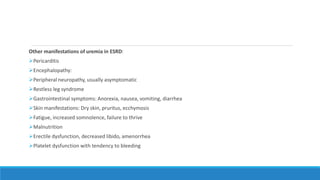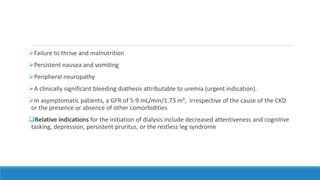Chronic kidney disease (CKD) is a major public health problem worldwide. It is defined as kidney damage or decreased kidney function lasting at least 3 months. CKD is staged based on glomerular filtration rate and albuminuria levels, with stage 5 being kidney failure. Common causes include diabetes, hypertension, and glomerulonephritis. Management involves treating underlying causes, slowing progression, and treating complications like anemia, bone disease, and fluid overload.



![Definition
Chronic kidney disease is defined as the presence of kidney damage (usually detected as
urinary albumin excretion of ≥30 mg/day or equivalent) or decreased kidney function (defined
as estimated glomerular filtration rate [eGFR] <60 mL/min/1.73 m2) for three or more months,
irrespective of the cause.](https://image.slidesharecdn.com/ckdpptdoc-221111181641-23c5cdc5/85/CKD-PPT-DOC-pptx-4-320.jpg)




![Assess GFR and albuminuria at least annually in people with CKD. Assess GFR and albuminuria
more often for individuals at higher risk of progression, and/ or where measurement will
impact therapeutic decisions. (Not Graded
Define CKD progression based on one or more of the following: Decline in GFR category (≥90
[G1], 60-89 [G2], 45-59 [G3a], 30-44 [G3b], 15-29 [G4], <15 [G5] ml/min/1.73m2).
A certain drop in eGFR is defined as a drop in GFR category accompanied by a 25% or greater
drop in eGFR from baseline.
Rapid progression is defined as a sustained decline in eGFR of more than 5 mL/1.73m2/year.
The confidence in assessing progression is increased with increasing number of serum
creatinine measurements and duration of follow-up.](https://image.slidesharecdn.com/ckdpptdoc-221111181641-23c5cdc5/85/CKD-PPT-DOC-pptx-9-320.jpg)

































